There’s a word in “Gen AI” that I want you to concentrate on: generative.
Next I’d like you to think about areas in your organisation where you can safely generate (and review what’s generated). This is probably not safe in your invoicing, product testing & QA, CRM records, etc. Those systems all use something else: facts. Facts cannot be generated.
The inordinate amount of hype around GenAI, including finance people on the Australian Broadcast Corporation (ABC Australia) talking about the demise of one company because “Gen AI can now do what their product tech was” is well out of proportion.
Have you noticed how the hyper about the Metaverse has dropped off?
And blockchain?
These are all great technologies, but lets face it, in the majority of cases they have very little to do with the core business of what your organisation does – unless you’re in the arts and creative industries.
There are fantastic demos from Adobe where they generate additional image content. There are prose, poems and fiction being generated. All of which is circling around and creating content from existing examples. It may look fresh, but its generated from existing input, but without human intuition, insight, or intelligence.
We see “director of GenAI” as a job title, but I think that will last about as long as “director of blockchain“.
These technologies do have a place – I called out Adobe above, and you may use their software – but remember, the advantage is to Adobe’s product, and probably not yours. You likely don’t work for Adobe (I’m not picking on them, but the data is in: most of the world does not work there). You’re likely to be a few layers down in the value chain. You’ll benefit from it, but I don’t think you’re going to be training your own LLMs. Someone else will, and they’ll charge you for it or figure out a way to recoup the expense by some method.
But remember, its generated. I can use GenAI to give me tonight’s lottery numbers. While plausible, they are unlikely to be correct.


